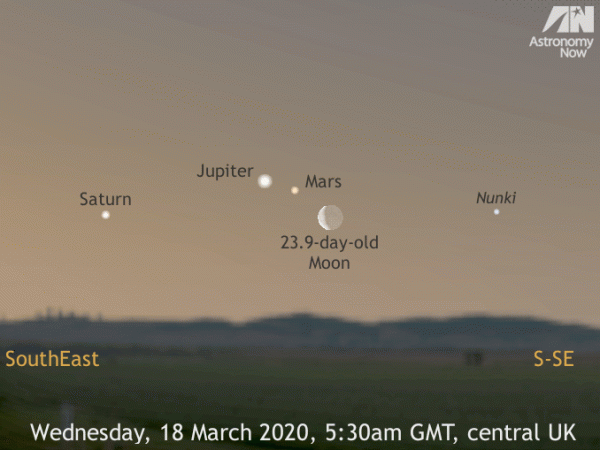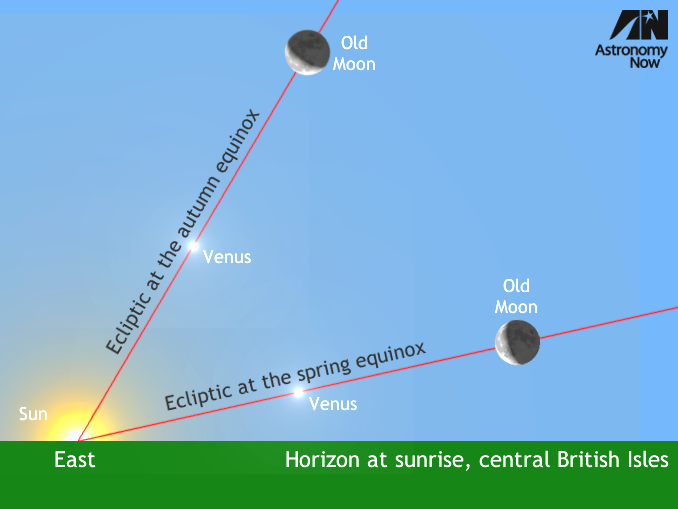See the old Moon join a dawn planetary parade, 18–19 March – Astronomy Now Online

If you’re an early riser in the British Isles fortunate enough to experience clear skies at dawn on 18 and 19 March, why not venture out around 5:30am GMT to see the old waning crescent Moon guide you to not just one, but three naked-eye planets — Mars, Jupiter and Saturn — all in the constellation of Sagittarius.
Unlike Venus’ current prominence high in the western sky at dusk, which is partly due to the steep angle that the ecliptic makes with the western horizon as seen from temperate northern latitudes such as the British Isles on the cusp of spring, the planets of the morning sky seem to hug the eastern horizon at dawn. (The reason for this is illustrated at the bottom of the page.)
Where and when to look
If we wish to view the old Moon in close proximity to the planets Mars, Jupiter and Saturn from the British Isles on 18 and 19 March, we therefore have a brief observing window. If we look too early, the sky will be darker, but the Moon and planets will be too close to the horizon to see. Conversely, if we leave it too late, our targets will be higher in the sky, but it will be too bright to see them.
Safety first! never leave your search so late as to look into the bright twilight of an impending sunrise with any optical instrument lest you accidentally view the Sun with catastrophic consequences for your eyesight.
For the heart of the UK, 5:30am is about the optimal time to look on 18 and 19 March once you’ve found a safe location that affords an unobstructed view of the southeast and south-southeast horizon. For Londoners, you need to look at about 5:24am. As seen from Cardiff, 5:36am is an optimal time to be scanning the southeast horizon, while those near the Scottish capital should look in the same direction close to 5:30am (all times GMT).
If you need truly localised viewing circumstances, do please consult our interactive online Almanac. (Click here for a user’s guide to the Almanac.)
What to look out for on 18 March
Consulting the animation at the top of the page reveals that for an observer in the heart of the British Isles, the almost 24-day-old waning lunar crescent lies just 6 degrees – little more than the half the span of a fist at arm’s length – above the south-southeast horizon. At this time, magnitude +0.9 Mars lies 2 degrees to the Moon’s upper left, while magnitude -2.1 Jupiter (almost 16 times brighter than the Red Planet) is a further 1.4 degrees to Mars’ upper right. Put simply, the celestial trio will comfortably fit within the field of view of typical 10×50 binoculars. Magnitude +0.7 Saturn lies 10 degrees, or the span of a fist at arm’s length, to the left of the Moon.
What to look out for on 19 March
Notice how much closer Mars is to Jupiter! The pair is little short of a degree apart this morning, but the Red Planet passes just 0.7 degrees south of Jupiter on the morning of Friday, 20 March. The almost 25-day-old Moon lies in the constellation of Capricornus at UK dawn on 19 March, some 4.1 degrees to the lower left of Saturn. The lunar crescent will be just 3 degrees high in the southeast, so can you glimpse the ringed planet and Moon in the same field of view of 10×50 binoculars this morning?







